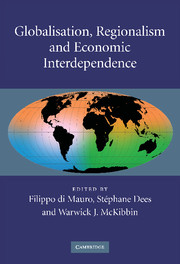Book contents
- Frontmatter
- Contents
- List of figures
- List of tables
- List of contributors
- Preface
- Introduction
- 1 International linkages in the context of global and regional integration
- 2 Trade integration of the central and eastern European countries and China: has it reached potential?
- 3 Patterns and determinants of production fragmentation in world manufacturing trade
- 4 Going global: trade, internationalisation of production and domestic performance of euro area firms
- 5 Globalisation and the trade channel in the euro area
- 6 Gauging the labour market effects of international trade openness: an application to the US manufacturing sector
- Index
- References
1 - International linkages in the context of global and regional integration
Published online by Cambridge University Press: 02 September 2009
- Frontmatter
- Contents
- List of figures
- List of tables
- List of contributors
- Preface
- Introduction
- 1 International linkages in the context of global and regional integration
- 2 Trade integration of the central and eastern European countries and China: has it reached potential?
- 3 Patterns and determinants of production fragmentation in world manufacturing trade
- 4 Going global: trade, internationalisation of production and domestic performance of euro area firms
- 5 Globalisation and the trade channel in the euro area
- 6 Gauging the labour market effects of international trade openness: an application to the US manufacturing sector
- Index
- References
Summary
Introduction
Fewer barriers to international transactions and rapidly spreading information technology lie at the root of the accelerating integration of markets worldwide. Although not a new phenomenon, ‘globalisation’ has become a popular term since the 1990s to describe the increasingly integrated and interdependent world economy, which has led to higher trade, production and services outsourcing, as well as the migration of highly skilled professionals (Hummels, 2007). As these developments have unfolded, economic integration at a regional level has also strengthened, as a result of tighter institutional arrangements as well as substantial pressure from market forces.
Every single country in the world is now a member of regional trade agreements and at least one regional bloc. More than one-third of world trade takes place within such arrangements. All regional agreements have the objective of reducing barriers to trade between member countries and therefore, implicitly, of discriminating against trade with non-member countries. At their simplest level, RTAs aim at reducing or removing altogether tariffs on trade flows between member countries, with some also eliminating non-tariff barriers and liberalising investment flows. At their deepest level, RTAs have the objective of achieving economic union, implying the creation of common institutions (Schiff and Winters, 2003).
- Type
- Chapter
- Information
- Publisher: Cambridge University PressPrint publication year: 2009
References
- 1
- Cited by



